Republicans face big risks in contested California races as Democrats fight for control of the House

- Share via
Reporting from Washington — Republicans are at risk of a wipeout in California’s six most hotly contested congressional races, a new poll shows — a result that could radically reshape the state’s political map, with major consequences nationally.
But the poll, conducted for the Los Angeles Times by UC Berkeley’s Institute for Governmental Studies, also underscores how close many of the contests remain.
The Democratic tide threatens to swamp congressional districts in Southern California’s suburbs that Republicans have controlled for decades. That would significantly boost Democrats’ chances of gaining the additional 23 seats they need to win a majority in the House.
But if the tide ebbs only slightly, the GOP could emerge with much of its control intact.
With the Nov. 6 midterm election less than five weeks away, none of the Republicans in the state’s six most competitive races have a lead. The Democrats lead strongly in one race and narrowly in three others, and two are dead heats, the Berkeley IGS Poll shows.
Reaction to President Trump appears to drive the results more than any specific issue and, in most cases, more than the individual candidates.
“Trump appears to be the main motivator for voters in these districts,” said Mark DiCamillo, the veteran pollster who directs the Berkeley IGS Poll. “He’s the central figure.”
The overall picture could change between now and election day, but voting by mail begins statewide Monday, and at least four major factors appear set:
Trump is unpopular across most of the targeted districts — four covering parts of Orange and San Diego counties, one in Los Angeles County and one centered on Modesto in the Central Valley. That’s especially true among college-educated white voters, whose alienation from the president has turned suburban districts across the country into risky territory for the GOP, and among Latinos and women.
The share of voters who approve of Trump serves as a ceiling for Republican candidates, with none able to surpass Trump’s level by more than a few percentage points. That’s a significant problem for Republicans; in five of the six districts, a majority of likely voters disapprove of the president’s performance in office.
In several districts, the president’s opponents appear more motivated to vote than his supporters, with self-identified liberals and registered Democrats more likely to say that they view this year’s election as more important than previous contests.
Strategies that the Republicans had hoped would bolster their campaigns and make up for the undertow from the president appear to have had limited effect, at best.
A ballot measure to repeal the recent increase in the state’s gas tax, which Republican operatives had hoped would spur turnout on their side, trails in each of the six highly competitive districts. Money for the repeal campaign has largely dried up as Republicans have diverted funds elsewhere.
A national effort by Republicans to portray untested Democratic candidates as unacceptably liberal appears also to have come up short in these California districts. Several Democratic newcomers have maintained favorable images with voters, the poll showed.
As a result of those factors, Republicans lag behind in two of the four congressional districts that cover most of Orange County, long the heartland of California conservatism. The other two contests are dead heats.
A longtime Republican incumbent, Rep. Steve Knight of Palmdale, is narrowly trailing in the only remaining L.A.-centered district the GOP holds.
Farther north, Republican Rep. Jeff Denham of Turlock, who has survived previous attempts by Democrats to oust him, is behind by a slim margin in his Central Valley race.
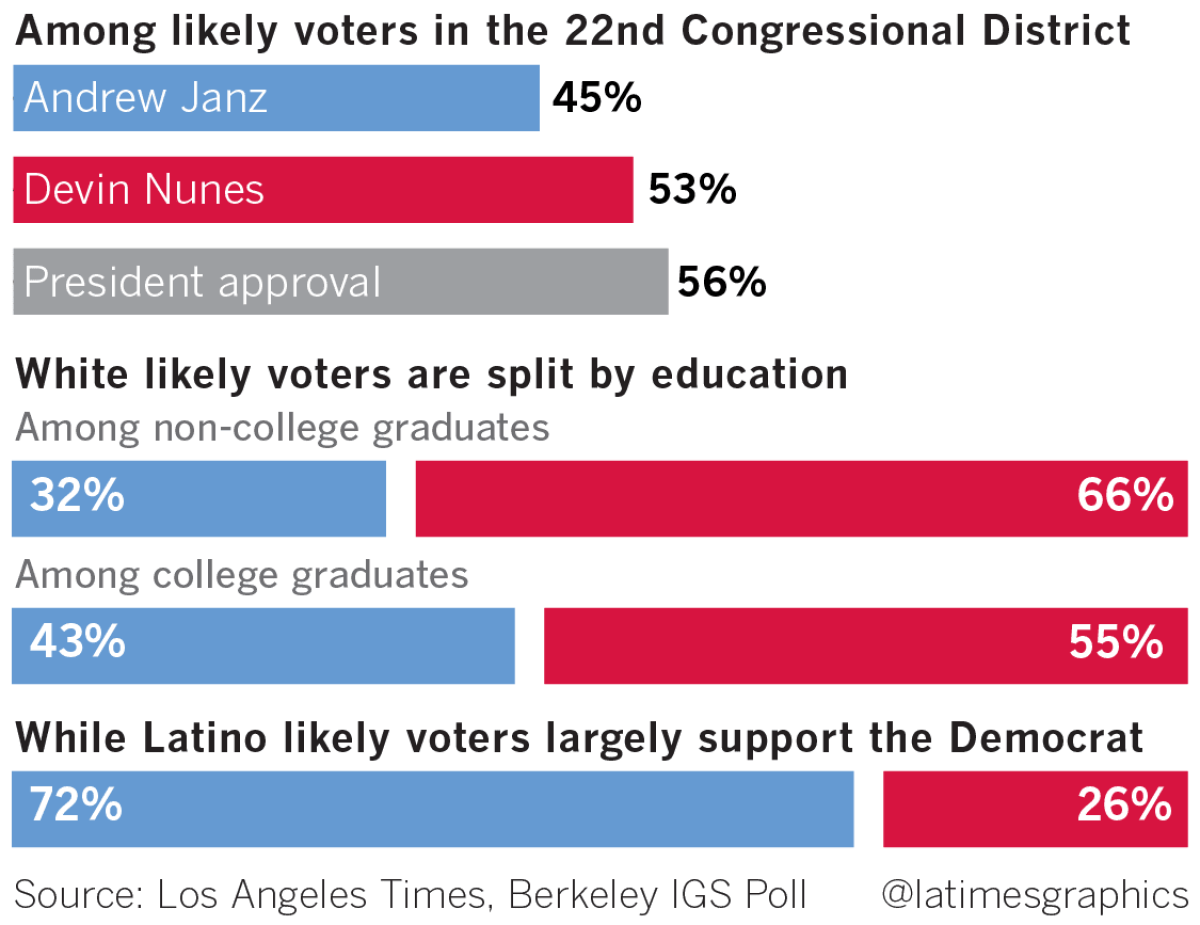
The poll’s findings in those districts are generally similar to other recent nonpartisan, publicly released surveys.
In addition to those six districts, the poll also surveyed the races in two Republican-held seats that have not been top Democratic targets but have attracted considerable attention.
Rep. Devin Nunes of Tulare, the chairman of the House Intelligence Committee, has a 53%-45% lead in his race against Andrew Janz, a county prosecutor. Nunes’ role as a defender of Trump has opened a gusher of money for Janz, despite the district’s heavily Republican tilt.
But in another heavily Republican district, Rep. Duncan Hunter of Alpine has only a 49%-47% lead over Democrat Ammar Campa-Najjar, a result well within the poll’s margin of error.

Hunter was recently indicted on federal fraud charges, turning a usually safe Republican district in inland San Diego and Riverside counties into a competitive one. He recently released a sharply negative ad that tries to link Campa-Najjar, who is of Mexican and Palestinian ancestry, to terrorism.
The poll findings in the six most contested districts illustrate the forces that have put the GOP’s majority at risk.
49th District
Democrats have their strongest shot in the 49th District, covering northern San Diego County and the southern Orange County coast up through Dana Point. Mike Levin, the Democrat, has a 55%-41% lead over Republican Diane Harkey, the poll shows. Republican Rep. Darrell Issa decided not to run for reelection in a district that Hillary Clinton carried by just more than 7 points in the 2016 presidential election.
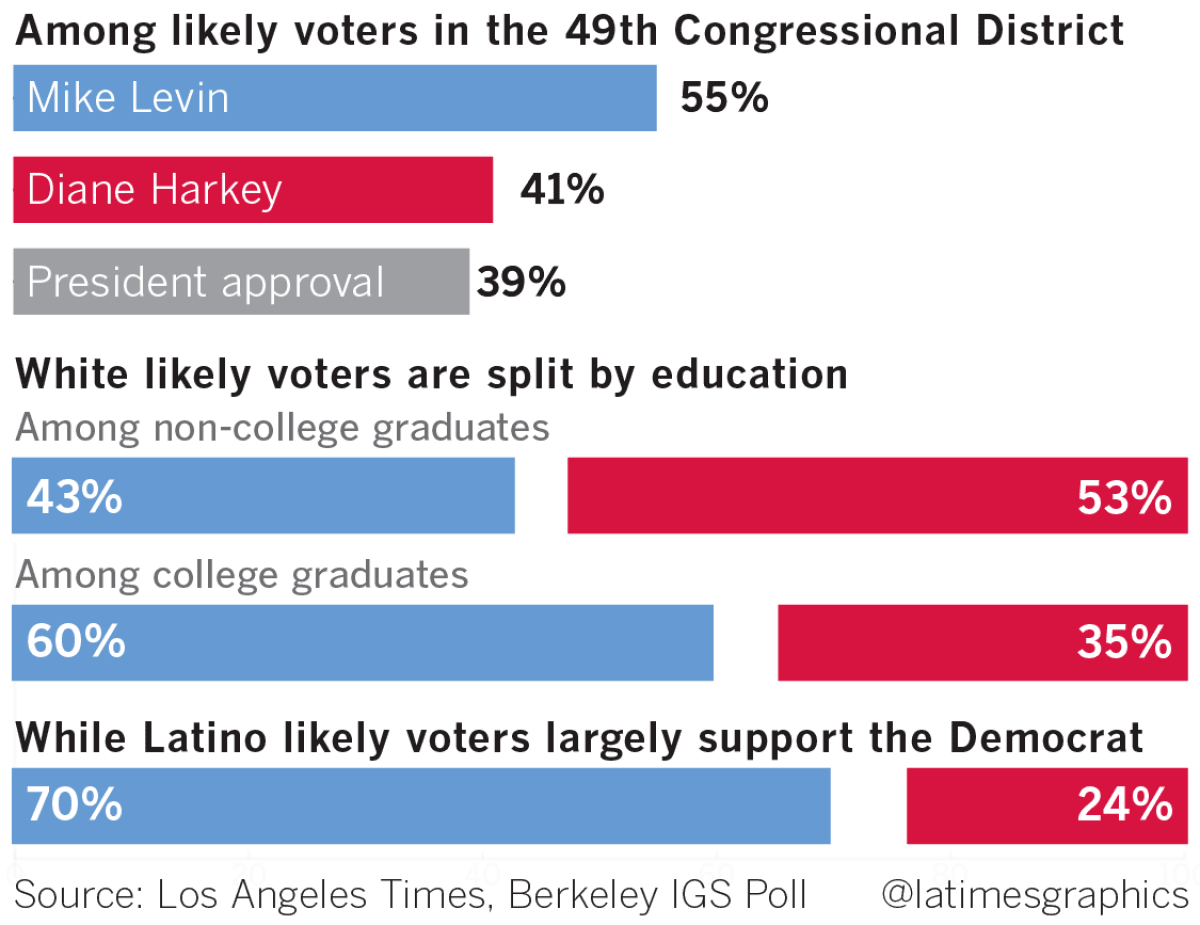
White voters with college degrees make up 45% of the likely voters in this mostly affluent, suburban district, and they back Levin 60% to 35%. Latinos, who make up about 1 in 8 likely voters here, back him by about a 3-1 majority. While men are divided almost evenly between the two, women favor Levin 60% to 34%.
Perhaps most important, likely voters disapprove of how Trump is doing as president 61% to 39%, with more than half, 55%, saying they strongly disapprove. Democrats and liberals were significantly more likely than Republicans and conservatives to say that it was “very important” for them to cast a vote to show their position on Trump.
48th District
Next door to the north, the 48th District, which spans the rest of the Orange County coast from Laguna Niguel to Seal Beach and inland to Westminster and Fountain Valley, is a couple of clicks more conservative. Clinton carried the district by less than 2 percentage points.
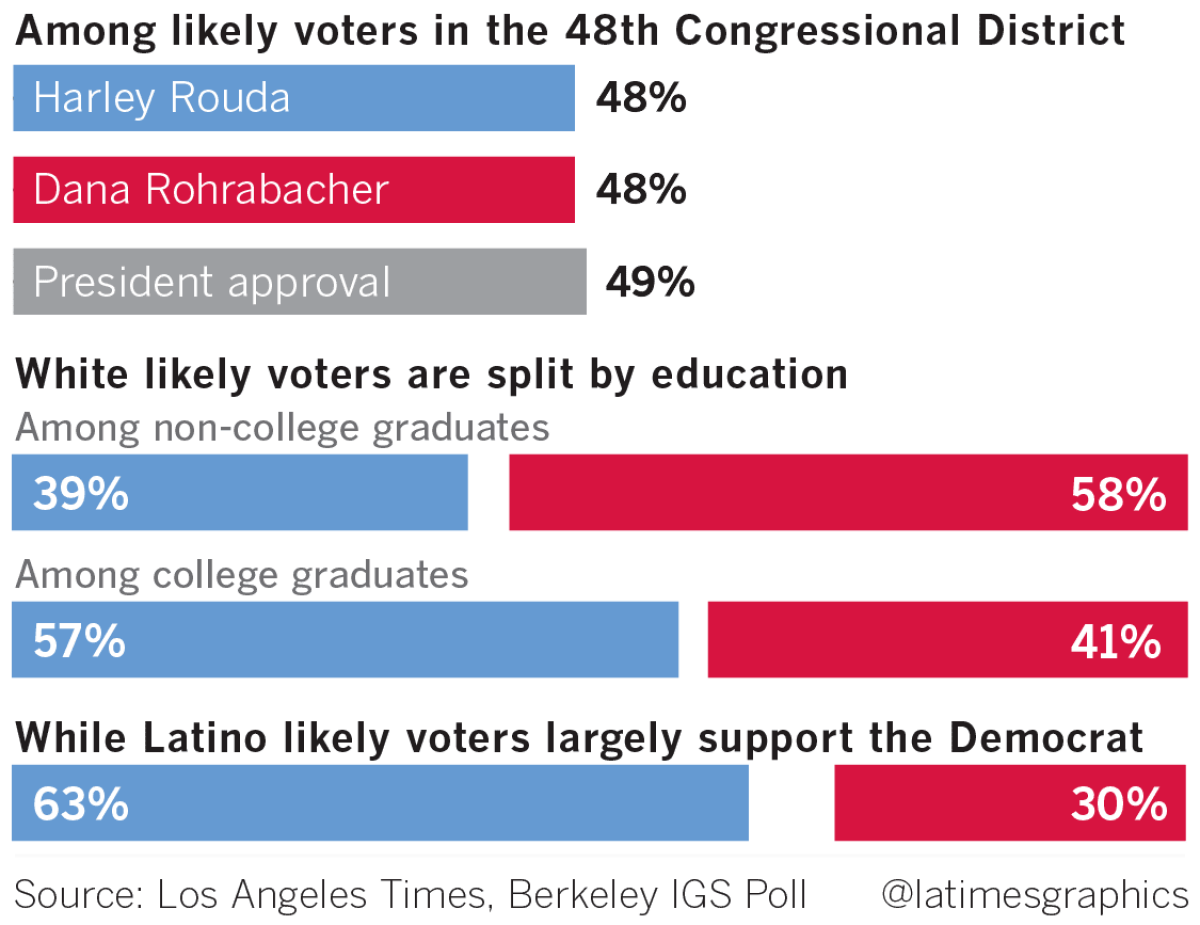
There, longtime Rep. Dana Rohrabacher of Costa Mesa and his Democratic challenger, Harley Rouda, are in a dead heat, each with 48%. Voters also split almost evenly on whether they approve of Trump.
As in the 49th District, college-educated white voters and Latinos back the Democrat, but they make up a slightly smaller share of the electorate: 39% of likely voters in the 48th District are whites with college degrees, and about 1 in 10 are Latino, the poll found.
Rohrabacher also benefits from significant support among Asian Americans, who make up about 1 in 8 of the likely voters. Elsewhere in California, Asian Americans lean heavily toward the Democrats, but this district includes a large, conservative Vietnamese population. Asian American voters overall divide almost equally between Rohrabacher and Rouda, the poll found.
Among whites without a college degree — the heart of Trump’s voting base — Rohrabacher leads by nearly 20 points, 58% to 39%, almost twice the size of the Republican’s margin with that group in the 49th District. Women support the Democrat, but men back the Republican by an almost equal margin.
The more Trump-oriented conservatism of the 48th District also surfaces when voters said what issues they care about most. Among Republicans in the 49th District, taxes were the top issue; in the 48th, it was “securing the nation’s borders.”
As the two sides vie to break the Rohrabacher-Rouda tie, the poll found a couple of weak spots.
Latino voters in the district were slightly less likely than others to say they viewed this election as more important than usual. That could hold down the Democratic vote.
Rohrabacher, however, has been dogged by controversy over his friendliness to people connected with Russia’s government. Unsurprisingly, an overwhelming share of Democrats said his contacts with Russian officials made them less likely to vote for Rohrabacher. So did 10% of registered Republicans. Among the small number of undecided voters, 45% said the Russia issue made them less likely to vote for him.
45th District
The 45th District, which covers a swath of Orange County from Irvine east through most of the foothill communities, resembles the 49th in its affluent, college-educated demographics. Clinton carried the district by 5 percentage points.

The Republican incumbent, Rep. Mimi Walters of Laguna Beach, had confidently predicted she could ride out the national tide flowing against her party, but the poll shows her Democratic challenger, UC Irvine law professor Katie Porter, leading 52% to 45%.
This race illustrates the failure so far of GOP strategies. Walters put money into helping get the gas tax repeal measure on the ballot, hoping it would spur GOP turnout. But the poll shows the measure getting only about a third of the vote in the district.
Republicans have also put millions into ads attacking Porter as too far to the left. That effort has had limited impact. By 50% to 38%, likely voters have a favorable opinion of Porter; self-identified moderates view her favorably 52% to 37%. By contrast, 50% of the district’s voters have a negative view of Walters, compared with 45% who see her positively.
39th District
The GOP may have had more success with negative ads in the 39th District, which covers much of northern Orange County as well as parts of Los Angeles and San Bernardino counties. Gil Cisneros has battled accusations that he sexually harassed a former Democratic state Assembly candidate, Melissa Fazli. A Republican super PAC allied with House Speaker Paul D. Ryan (R-Wis.) has run advertisements in the district about the charge.
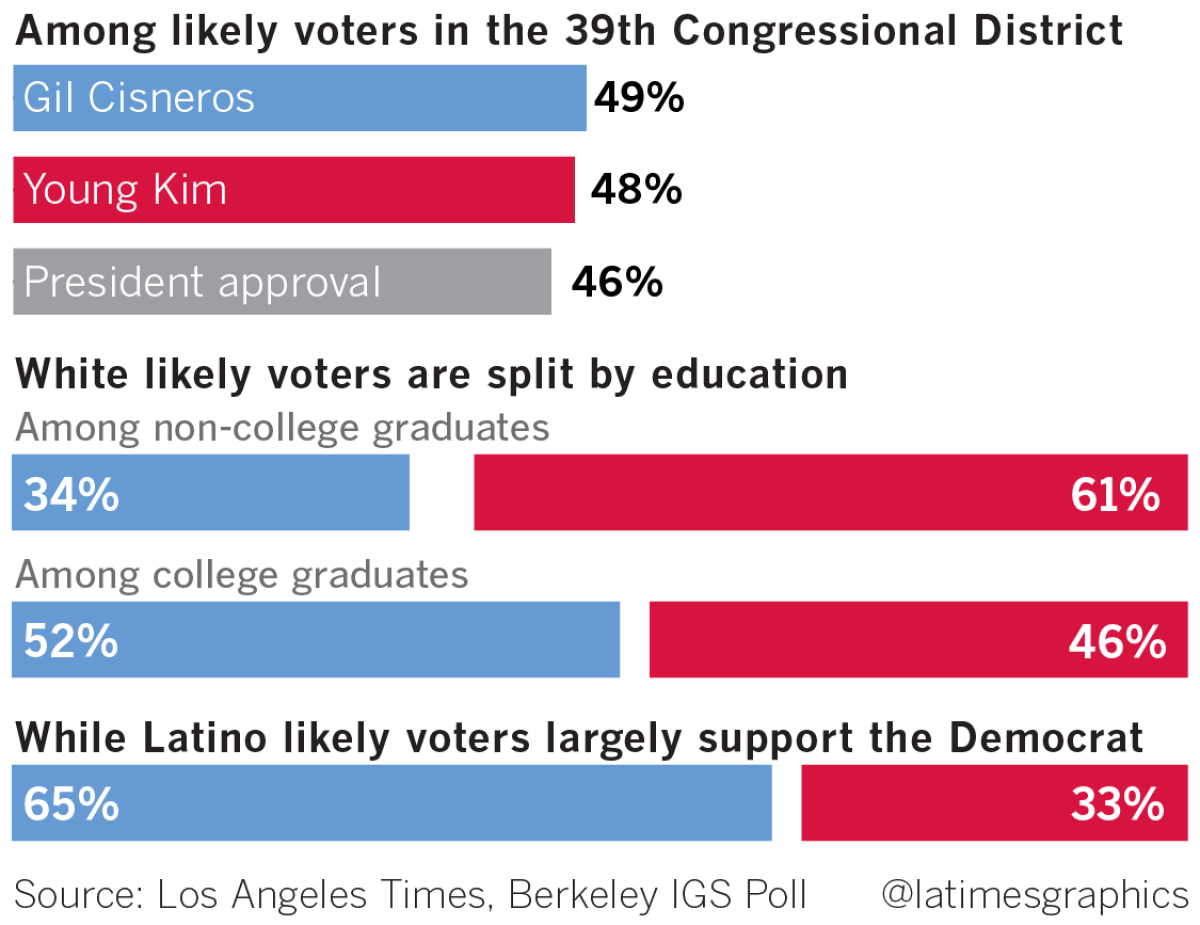
Fazli withdrew the accusation this week after a meeting with Cisneros, saying it was based on a “misunderstanding.” The super PAC said it would stop running the ads.
The poll can’t directly measure the impact of that issue, but 45% of likely voters have a negative view of Cisneros. That includes 10% of registered Democrats. Just 41% of likely voters view him positively.
Cisneros and Republican Young Kim are locked in a dead heat, the poll showed, with the Democrat holding a nominal 49%-48% edge.
25th District
The demographic picture looks somewhat different in northern Los Angeles County, where Republican Rep. Steve Knight hopes to hold off a challenge from Katie Hill, the 31-year-old former executive director of PATH, a nonprofit organization that provides services to homeless people.
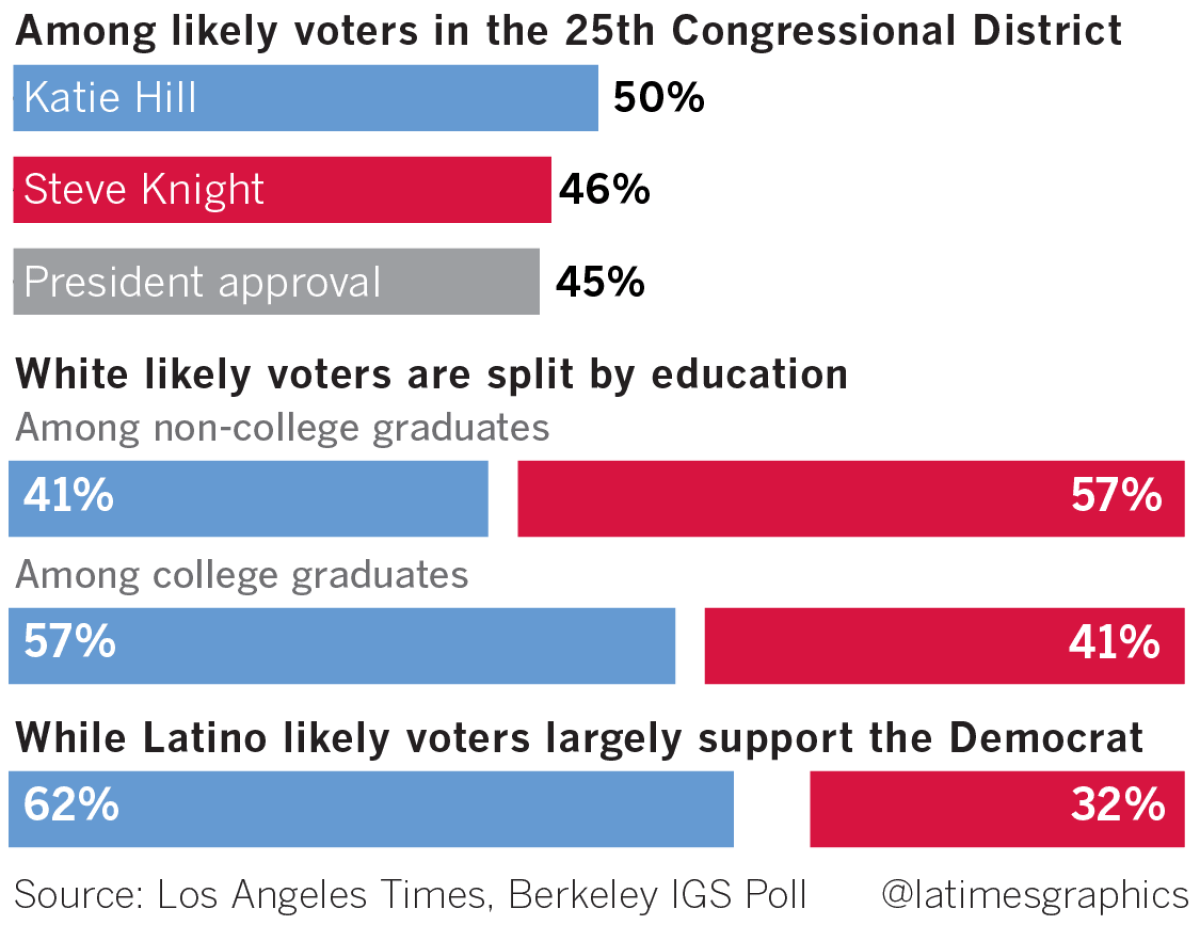
Hill has a slight edge, 50% to 46%, within the poll’s margin of error.
The district, which covers Simi Valley, Santa Clarita and the Palmdale area, has fewer college-educated white voters than the wealthy Orange County suburbs. But it has a higher share of minority voters.
Latinos make up a bit more than 1 in 5 of the district’s likely voters and support Hill by nearly 2 to 1, the poll found. Hill also benefits from a significant gender gap, with women backing her 53% to 44% over Knight, while men split almost evenly. Just over half of the voters have a strongly negative view of Trump.
10th District

Similar factors have put Republican Rep. Jeff Denham’s career at risk as he seeks a fifth term in a district centered on Modesto in the Central Valley, where Latinos make up more than 40% of the district’s population, but about a quarter of the likely voters.
Denham’s Democratic opponent, Josh Harder, has the support of roughly two-thirds of Latinos, the poll found.
White voters split 52% for Denham, 43% for Harder. Together, that’s enough to give the Democrat a 50%-45% edge in a district that Clinton narrowly carried in 2016 and where 57% of voters say they disapprove of Trump.
::
The Berkeley IGS Poll, which was done for the Los Angeles Times, surveyed 5,090 likely voters online in eight congressional districts — the 10th, 22nd, 25th, 39th, 45th, 48th, 49th and 50th — from Sept. 16 to 23, using a random sample solicited by email from the state voter file. The number of likely voters in each district varies from 912 in the 22nd district to 519 in the 45th. The margin of error for the likely voter samples ranges from roughly 4 to 6 percentage points in either direction. For a detailed description of the poll’s methodology, go to latimes.com/poll.
Get the latest news from the nation’s capital on Essential Washington >> »
Twitter: @DavidLauter
More to Read
Get the L.A. Times Politics newsletter
Deeply reported insights into legislation, politics and policy from Sacramento, Washington and beyond. In your inbox three times per week.
You may occasionally receive promotional content from the Los Angeles Times.








